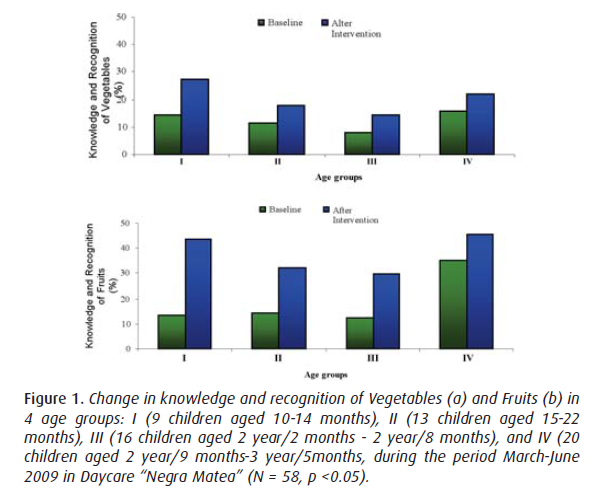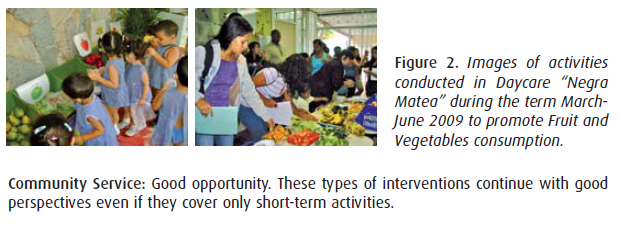LIFE RESOURCE AND CULTURAL HERITAGE »
Fruit and Vegetable promotion in children of a Caracas Daycare by students enrolled in Community Service of the Faculty of Science of “Universidad Central de Venezuela”
Venezuela: a country with opportunities for launching F&V promotional programs
The growing epidemic of Non-Communicable Diseases (NCD) related to changes in eating habits and unhealthy lifestyles, and the fact that chronic diseases are also among the leading causes of mortality in Venezuela, provided motivation to launch the “5 a Day” initiative from Universidad Central de Venezuela (UCV). Fruit and Vegetables (F&V) have not had a significant presence in Venezuelan official health programs or in policies for prevention of NCD, even if recommended by food guides. With an alarming increase of overweight and obesity in children, Venezuela has multiple opportunities for launching F&V promotional programs1. UCV has been trying to disseminate the campaign and gain support from other institutions and sectors of society interested in increasing the awareness of the health benefits associated with the consumption of F&V and increased physical activity.
The Venezuelan Law of Community Service for Students of Higher Education
This process has been assisted by a unique opportunity provided by the legal framework of the Law of Community Service for Students of Higher Education that was enacted in 2005. Given this timely situation, the project “5 a Day educational campaigns in the context of the Community Service Guidelines of the Faculty of Sciences at UCV” was initiated. This represents a formidable chance to permeate public schools with educational and entertaining activities regarding F&V, employing the driving force of committed students who have previously being instructed in the WHO/FAO joint Initiative to promote fruit and vegetables for health worldwide2.
Intervention in a Daycare institution for children of UCV´s
employees “Maternal Negra Matea”: An example of what
Community Service students do
In this work are presented the results of a short intervention (March-June 2009), performed by two undergraduate students of UCV. The intervention took place in a Daycare institution for children of UCV´s employees “Maternal Negra Matea”. It included a sample of 58 children of both sexes: infants, toddlers, and pre-schoolers, categorized in four groups. Their parents and 18 workers of the Center were also included in final activities.
The intervention was conducted in four stages:
- Evaluation of the children´s initial knowledge of F&V (recognition and identification) using color images.
Group dynamics activities geared to reinforce knowledge of F&V (nursery rhymes, exercise and dances, puppet/story theatre with F&V costumes). Children participated in supervised feeding of two tortoises – pets belonging to the Daycare – with leafy vegetables. All activities were adapted to the ages of the sample.
Verification of F&V preferences. A mini-market was implemented in the Daycare where children could make a selection and “buy” F&V of their preference. Their selection was recorded. In subsequent activities, a tasting of 12 fruits and 10 vegetables was conducted under the guidance of the dietitian of the nursery. - F&V Fair. The same F&V presented to the children were presented to their parents and staff (also with children at the Daycare) in a final activity. Their response was recorded. Additionally, parents were presented with “5 a Day” report cards with results and scores of their children throughout the activities undertaken during the term, and received a motivational talk on the benefits of F&V consumption.
The relationship between knowledge of F&V (initial and after the intervention) was determined. Many F&V initially presented to the children were unknown to them, and after the intervention their knowledge increased 6-13% for vegetables and 10-35% for fruits (Figure 1). Children were able to recognize a greater number of fruits (45%) as opposed to vegetables (27%).

The correlation between knowledge and F&V preference was not statistically significant (p> 0.05) in Groups I and II, while groups III and IV were willing to try and eat mostly F&V that they knew and recognized (p<0.05). This agrees with Busick et al.3, who reported a weak correlation between the child’s ability to name the F&V and its willingness to try them. The acceptance of food in preschool children is often considered a basic preference behavior highly correlated with unrestricted consumption, establishing a measure of what children are willing to eat if they are offered: when children are offered to try new flavors repeatedly without coercion, they learn to accept new foods that had previously been rejected4.
Results were compared with those reported by parents and staff on taste and preference in the F&V Fair. A weak relationship between the groups, parents and staff, was observed indicating that the disposition of children to test the different F&V was poorly correlated with the tastes of the adult population that interacts with them (p>0.05). This needs to be further investigated since the F&V Fair was the sole event where this was measured. However, adult´s awareness of the importance of F&V was perceived.

References
- Olaizola C, Esté ME, Tapia MS et al. Rev Chil Nut. 2006; 33 Supl 1:306-315.
- Tapia MS., Olaizola C and Delgado-Mora E. Rev Española Nutrición Comunitaria 2010; 6:45-50.
- Busick D, Brooks J, Pernecky S et al. Appetite 2008; 51:468–473.
- Contento I, Randell JS, Basch C. J Nutr Educ Behav 2002; 34(1):2-25.
